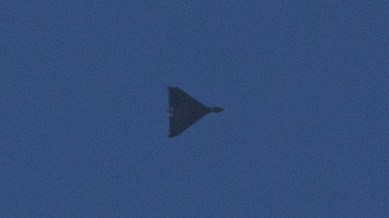NATO shoots down Russian drones in Polish airspace. Here is what to know
Tusk said Poland had successfully repelled the attack and insisted that “there is no reason to panic”, but added that military conflict was “closer than at any time since the second world war”.

NATO fighter jets intercepted and shot down several Russian drones that crossed into Polish airspace during strikes on Ukraine early Wednesday, in what Poland’s prime minister Donald Tusk called an attempt closer to military conflict “than at any time since the second world war.”
The incident marked the first time NATO forces have fired shots since the war in Ukraine began. According to officials, Polish and Dutch jets led the operation, supported by Italian, German, and other multinational NATO units.
Reacting to the attack, Russia rejected claims that its drones had deliberately crossed into Polish territory, insisting the incident was being misrepresented. The Foreign Ministry said evidence already presented by the Defence Ministry disproved what it called “myths” about intentional violations of Poland’s airspace.
Russia’s chargé d’affaires in Poland, Andrei Ordash, termed the accusations against Moscow groundless, saying that “no evidence has been presented proving these drones are of Russian origin”.
Here’s what to know.
- 01
Drones enter Polish airspace
Poland scrambled both its national and NATO air defences on Wednesday morning to intercept several drones that entered its airspace, marking the first significant spillover of Russia’s attack on Ukraine into NATO territory since the full-scale invasion began over three years ago.
- 02
PM Tusk holds emergency meeting
Prime Minister Donald Tusk convened an emergency meeting with the council of ministers at 8am local time, emphasising that the situation represented a “large-scale provocation” and assuring citizens that Poland was prepared for any scenario. He added that while the threat was serious, there was no reason to panic.
“We are dealing with a large-scale provocation … We are ready to repel such provocations. The situation is serious, and no one doubts that we must prepare for various scenarios,” said Tusk at the meeting, The Guardian reported.
Poland confirmed that at least three drones were shot down, and more than ten potentially threatening objects were “neutralised” by its air defence systems. Some drones reportedly entered from Belarusian territory, prompting heightened vigilance along the border.
- 03
NATO article 4 invoked
Tusk announced that Poland would invoke NATO’s Article 4, which calls for formal consultations among member states. The article has been invoked only seven times since NATO’s founding in 1949, most recently in 2022 following Russia’s initial full-scale invasion of Ukraine.
- 04
NATO jets assist interception
The Dutch Prime Minister, Dick Schoof, said F-35 jets from the Netherlands participated in the interception, highlighting NATO’s rapid coordination. Polish authorities also confirmed that one drone struck a residential building in eastern Poland, though there were no immediate reports of casualties, The Guardian reported.
- 05
'Here we go!'
US president Donald Trump also reacted to the Russian incursion into Polish airspace last night, saying on Truth Social: What’s with Russia violating Poland’s airspace with drones? Here we go!
- 06
Russia strikes Ukraine overnight
Meanwhile, Ukraine’s President, Volodymyr Zelenskyy, reported that the overnight Russian offensive included 415 drones and 40 missiles, most targeting western Ukraine. He stressed that the drones entering Polish airspace could not have been accidental and called for a strong NATO response.
“Moscow is always testing the limits of the possible, and if it does not meet a strong reaction, moves to a new level of escalation,” wrote Zelenskyy in a post on X. “Today was another escalatory step … Not one ‘Shahed’, which could have been called an accident, but at least eight attack drones which targeted Poland.”
Earlier in the day, Russia's Defence Ministry confirmed it had launched a large-scale strike on military facilities in western Ukraine but stressed that no targets in Poland were intended.
- 07
Ukraine calls for regional defence
Ukrainian foreign minister Andriy Sybiha urged neighbouring countries to take active measures to intercept Russian missiles and drones over Ukrainian territory, especially near NATO borders, arguing that collective security depended on such action. However, Moscow also signalled it was open to dialogue, saying both the Defence and Foreign Ministries were prepared to hold consultations with their Polish counterparts to address the issue.
- 08
EU plans eastern ‘drone wall’
The European Union’s defence commissioner, Andrius Kubilius, called for the creation of a “drone wall” along Europe’s eastern flank to prevent future incursions, stressing the need for cooperation between member states, frontier countries, and Ukraine.
“Once again Russia tests frontier states, EU & Nato,” Kubilius wrote in a post on social media platform X. He added: “We shall work together with member states, frontier countries and Ukraine. Russia will be stopped.”
- 09
Airports temporarily closed
The drone strikes coincided with heightened regional tensions ahead of the Russia-Belarus Zapad military drills, leading Poland to close several airports, including Warsaw’s Chopin Airport, as well as key hubs in Rzeszów and other southeastern cities. Early morning flights were delayed or diverted.
- 10
Rising tensions with Russia
The strikes follow warnings from Poland’s new nationalist president, Karol Nawrocki, who claimed Russia was prepared to expand its military aggression beyond Ukraine. Russia has been carrying out near-nightly assaults on Ukraine with Iranian-designed kamikaze drones, commonly referred to as “Shaheds.”
With previous attempts at negotiation, including a recent US-Russia summit in Alaska, yielding minimal progress, Poland and Kyiv are now seeking stronger international deterrence against Moscow.